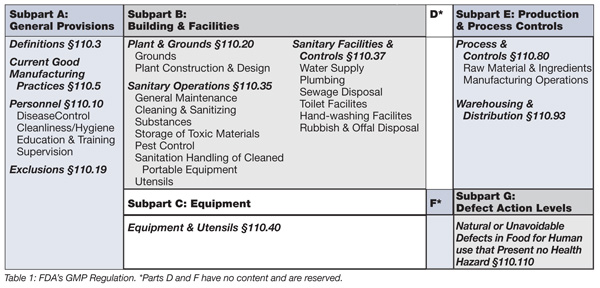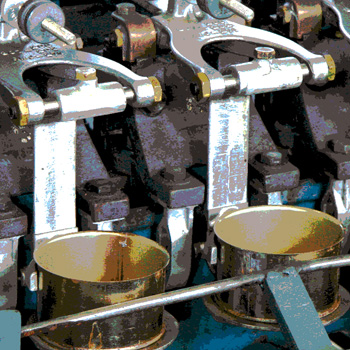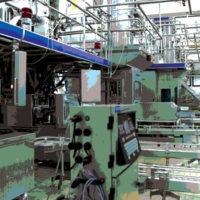Good manufacturing practices (GMPs) describe the conditions and practices that are necessary for the manufacturing, processing, packing or storage of food to ensure its safety and wholesomeness. The current GMPs comprise the basis for determining whether the practices, conditions and controls used to process, handle or store food products are safe and whether the conditions in the facility are sanitary.
The current federal GMP regulation specifically applies to all food products regulated by FDA. This regulation can be found in Part 110 of Title 21 of the Code of Federal Regulations. It outlines the basic sanitary controls that are required for all food processing plants, wholesale or food distribution firms and food storage facilities that handle, store or process FDA-regulated food. This GMP regulation also provides a framework for the specific state regulations that may apply to these firms, and for the specific regulations for animal foods that are regulated by the USDA.
 Table 1 shows an overview of FDA’s GMP regulation to illustrate how it is organized and what it covers. It is divided into 7 subparts, and each subpart includes various sections that are identified with a series of numbers that start with the symbol § and the number 110. The specific topics covered in each of these sections of the GMP regulation are then listed.
Table 1 shows an overview of FDA’s GMP regulation to illustrate how it is organized and what it covers. It is divided into 7 subparts, and each subpart includes various sections that are identified with a series of numbers that start with the symbol § and the number 110. The specific topics covered in each of these sections of the GMP regulation are then listed.
The GMP regulations are designed to be the "minimum" standards for the food industry. Because the GMP regulation is general in nature, it uses words such as "adequate," "appropriate" or "as necessary." Each firm must develop and implement procedures for each GMP requirement that will protect the food that they receive, store or process from contamination. These procedures are specific to each firm since they are developed to meet the unique needs of the facility and their food products, processes and equipment. There may be many different strategies that are "adequate" or "appropriate" for different situations. The GMP is designed to provide this flexibility.
Each firm must develop procedures to ensure that an effective food safety program has been implemented, and that adequate supervision and monitoring systems are in place to ensure that problems are identified and promptly corrected. A team consisting of plant workers, managers, supervisors and quality control staff is likely to be involved in the routine activities and tasks in the facility, ensuring that each firm meets the requirements and conditions outlined in the GMP regulation.
Training is essential to ensure that each person in this system understands their roles and responsibilities related to the requirements of the GMP regulation and their firm’s procedures to ensure compliance. Different types of training are needed for individuals with different roles and responsibilities. Managers, supervisors, quality control staff and others with overall responsibilities for developing and implementing effective procedures to meet GMP requirements should understand or be aware of all of the GMP requirements and appropriate strategies to meet them. These individuals are likely to need more comprehensive training than production or other workers assigned to more directed tasks.
One of the more difficult challenges for many smaller businesses is to convert the general conditions and practices described in the GMP regulation into routine or periodic procedures that will ensure compliance. A new GMP internet course (see sidebar) is designed to help with this process.
Delivering adequate training is an ongoing challenge for the food industry. According to the U.S. Census Bureau’s 2005 Statistics of U.S. Businesses (http://www2.census.gov/csd/susb/2005/usalli05.xls), there were 25,785 establishments involved in food manufacturing, 33,867 wholesale establishments of grocery and related products, 6,754 wholesale establishments of farm product raw materials and 1,883 refrigerated or farm product warehouse or storage facilities. These firms employed over 2.3 million individuals. These statistics underscore the scope of the challenges associated with development and delivery of effective training to ensure food safety. This challenge was recently highlighted in the 2005 report of the FDA’s food current GMP modernization working group (http://www.cfsan.fda.gov/~dms/ cgmps3.html). One of the key modernization opportunities that this group identified was to "require appropriate training for supervisors and workers to ensure that they have the necessary knowledge and expertise in food hygiene, food protection, employee health and personal hygiene to produce safe products." The new Cornell internet-based training program will provide another tool to help the large number of firms who must meet basic GMP requirements train their employees. Having these training tools available before the FDA completes its GMP modernization effort may also create a "teachable moment" for most firms and ensure they have the latest information on how to meet GMP requirements.
Read the sidebar "GMPs: A New Internet Course from Cornell"
Ken Gall is the Senior Extension Associate at the New York Sea Grant and Cornell Cooperative Extension at SUNY — Stony Brook. He can be reached at klg9@cornell.edu.
GMPs: A New Internet Course from Cornell
A new internet training program on the current GMP regulation has been developed to provide this type of training for middle level managers and others with routine responsibilities for food safety and sanitation procedures in food processing, manufacturing, wholesale and warehouse or storage facilities. This training course was developed for a USDA/CSREES National Food Safety Initiative project (Project No. 2005-51110-03291), and is hosted and managed by Cornell Cooperative Extension and the New York Sea Grant program. Background information and online registration is available at http://gmptraining.aem.cornell.edu. This internet-based distance education course consists of twelve modules that cover all of the parts of the current GMP regulation. After discussing each requirement in the GMP regulation, practical tips are provided that describe "what you can do" to meet that requirement along with suggestions for monitoring that condition or practice. At the end of each module, a checklist of conditions, procedures or practices that need to be developed to meet the sections of the GMP regulation that were reviewed is provided along with links to internet resources for more detailed information. The course is available on demand at a low cost. Each student is tracked by a unique username and password, and upon completion of all course materials, a certificate of course completion is provided to document the training. A Spanish language version of the course will be available in the fall of 2008.
Individuals who complete this internet course are also likely to be the same individuals who are involved in routine supervision or more directed training programs for plant workers. Short training modules that are designed to provide a framework for this type of training will be provided to those who complete the course on GMPs. Five modules that cover specific topics that are relevant to the type of training needed for most plant workers are available on: Employee Health and Hygiene; Proper Hand Washing; Cleaning and Sanitizing; Production Controls; and Process Controls. These programs are in a PowerPoint® format that can be delivered using traditional projection equipment, viewed directly on a computer screen or distributed to employees as printed handouts. These training modules are designed to cover basic concepts and provide the opportunity to discuss company-specific requirements and policies.




